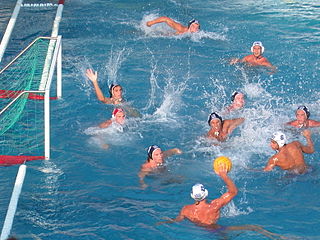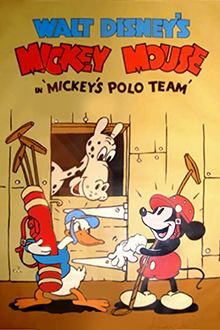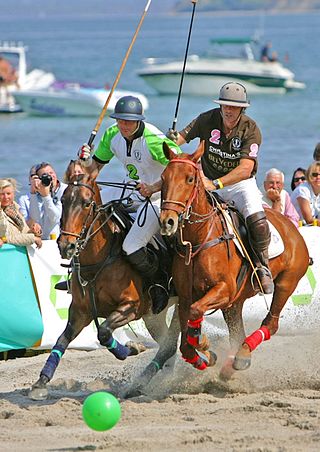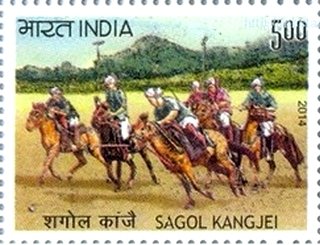
Field hockey is a team sport structured in standard hockey format, in which each team plays with 11 players in total, made up of 10 field players and a goalkeeper. Teams must move a hockey ball around a field by hitting it with a hockey stick towards the rival team's shooting circle and then into the goal. The match is won by the team that scores the most goals. Matches are played on grass, watered turf, artificial turf, or indoor boarded surface.

Polo or Chovgan is a ball game that is played on horseback, a traditional field sport and one of the world's oldest known team sports. It originated in ancient Persia, dating back over 2,000 years. Initially played by Persian nobility as a training exercise for cavalry units, polo eventually spread to other parts of the world. The game is played by two opposing teams with the objective of scoring using a long-handled wooden mallet to hit a small hard ball through the opposing team's goal. Each team has four mounted riders, and the game usually lasts one to two hours, divided into periods called chukkas or chukkers.

Water polo is a competitive team sport played in water between two teams of seven players each. The game consists of four quarters in which the teams attempt to score goals by throwing the ball into the opposing team's goal. The team with more goals at the end of the game wins the match. Each team is made up of six field players and one goalkeeper. Excluding the goalkeeper, players participate in both offensive and defensive roles. It is typically played in an all-deep pool where players cannot touch the bottom.
Canoe polo, also known as kayak polo or polo, is one of the competitive disciplines of kayaking. It incorporates ball-handling skills into a contact team game, wherein group tactics and positional play are as important as individual speed and fitness.

Mickey's Polo Team is a 1936 American animated short film produced by Walt Disney Productions and released by United Artists. The cartoon features a game of polo played between four Disney characters, led by Mickey Mouse, and four cartoon versions of real-life movie stars. It was directed by David Hand and was first released on January 4, 1936. The film was inspired by Walt Disney's personal love of polo. It was the 80th Mickey Mouse short film to be released, and the first of that year.

Polocrosse is a team sport that is a combination of polo and lacrosse. It is played outside, on a field, on horseback. Each rider uses a cane or fiberglass stick to which is attached a racquet head with a loose, thread net, in which the ball is carried. The ball is made of sponge rubber and is approximately four inches across. The objective is to score goals by throwing the ball between the opposing team's goal posts.

The Duden is a dictionary of the Standard High German language, first published by Konrad Duden in 1880, and later by Bibliographisches Institut GmbH, which was merged into Cornelsen Verlag in 2022 and thus ceased to exist.

Underwater rugby (UWR) is an underwater team sport in which two teams compete to score a negatively buoyant ball into the opponents’ goal at the bottom of a swimming pool. It originated from the physical fitness training programs in German diving clubs during the early 1960s. Recognised by the Confédération Mondiale des Activités Subaquatiques (CMAS) in 1978, It was first played in a world championship in 1980.

Cycle polo, bicycle polo, or bike polo is a team sport, similar to traditional polo, except that bicycles are used instead of horses. There are two versions of the sport: Hardcourt Bike Polo and grass court bike polo. The hardcourt game saw a sharp spike in interest in the first decade of the 21st century and new teams are sprouting up across the world in China, Canada, Ireland, Switzerland, France, India, Germany, Pakistan, Ukraine, Russia, Malaysia, Sri Lanka, Indonesia, Hungary, Australia, New Zealand, Sweden, England, Scotland, Argentina, Italy, Spain, United States, Poland, Croatia, Slovenia, Lithuania, Nepal, Brazil and Cuba.

The laws of Australian rules football were first defined by the Melbourne Football Club in 1859 and have been amended over the years as Australian rules football evolved into its modern form. The Australian Football Council (AFC), was formed in 1905 and became responsible for the laws, although individual leagues retained a wide discretion to vary them. Following the restructure of the Victorian Football League's competition as a national competition and the League's renaming to be the Australian Football League (AFL), since 1994, the rules for the game have been maintained by the AFL through its Commission and its Competition Committee.

Segway polo is a team sport which started to gain some measure of popularity after being played by members of the Bay Area Segway Enthusiasts Group in 2004. The Bay Area SEG was not the first to play polo on a Segway HT; a team sponsored by Mobile Entertainment played in the Hubert H. Humphrey Metrodome at a Minnesota Vikings halftime show in 2003 although the Bay Area SEG members were not aware of this match at the time they first played the sport. Segway polo was developed as it is played today by the members of the Bay Area SEG and other groups and teams that have joined subsequently.

The Federation of International Polo (FIP) is the international federation representing the sport of polo, officially recognized by the International Olympic Committee. The FIP was founded in 1982 by representatives of eleven national polo associations, and it represents the national polo associations of more than 80 countries. Its principal aim is to enhance the international image and status of polo.

Hardcourt Bike Polo is a fast-paced, gender-inclusive team sport played on a hard, smooth, often trapezoidal, enclosed court. Three players per team ride bicycles and use mallets to hit a small ball into the opposing team's goal while avoiding physical contact with the ground. From its emergence in the 1990s, the sport benefited greatly from in the 2010s' bike boom seeing the formation of international clubs and the growth of a strong tournament culture. Drawing from aspects of team sports and cycling, its unique blend of brutal difficulty, finesse, physicality and flow attracts spectators and players alike, creating a passionate and vibrant sporting culture.
The 19th DSB Congress, comprising several tournaments, began on 20 July 1914 in Mannheim. Germany declared war on Russia and on France, Britain joining in the next day. The congress was stopped on 1 August 1914.

Beach polo is a team sport and close variant of arena polo.
Cowboy polo is a variation of polo played mostly in the western United States. Like regular polo, it is played in chukkas (periods) with two teams on horses who use mallets to hit a ball through a goal. It differs from traditional polo in that five riders make up a team instead of four, western saddles and equipment are used, and the playing field is usually a simple rodeo arena or other enclosed dirt area, indoors or out. Also, instead of the small ball used in traditional polo, the players use a large red rubber medicine ball and use mallets with long fiberglass shafts and hard rubber heads.
Rege Ludwig is a polo instructor and high-goal coach who has been playing and instructing polo for over 30 years.

A hobby horse is a child's toy horse. Children played at riding a wooden hobby horse made of a straight stick with a small horse's head, and perhaps reins, attached to one end. The bottom end of the stick sometimes had a small wheel or wheels attached. This toy was also sometimes known as a cock horse or stick horse.

India is the birthplace of modern polo. The modern game of polo is derived from Manipur, where the game was known as sagol kangjei, kanjai-bazee, or pulu. It was the anglicised form of the last, referring to the wooden ball that was used, which was adopted by the sport in its slow spread to the west.

Sagol Kangjei is a traditional Meitei ball sport played on horseback with a long-handled stick. The sport, also known as Manipuri polo, is a predecessor of modern international polo.
















